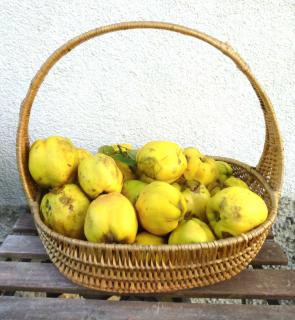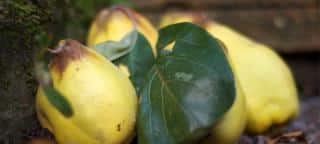

Quince, or Cydonia vulgaris is harvested from the quince tree and is a fruit that has many health benefits for the body. This yellow pear-shaped fruit belongs to the Rosaceae family. Quince trees are native to Asia Minor, can reach up to 16 feet (5 m) tall. In spring, it bears pink or white flowers.
Quince fruits mature in fall.
Three main varieties are on the market currently: the ‘Champion’, the ‘Vranja Giant’ and the ‘Portugese quince’.
Quince is actually where the word “marmalade” comes from. Indeed, the Greek word “marmalada” meant “quince jam“.
Quince has been grown for over 4000 years before Jesus-Christ, along the coast of the Caspian Sea.
Greeks loved eating it with honey. They connected this fruit to Aphrodite, the goddess of love and fertility.
Romans used quince for its fragrance: they made perfume from it.
Arabs were already using it for its medicinal properties.
In the Middle Ages, the wealthy would bite into it regularly, as a sign of their power.
Quince cares for your intestines.

Combined, fibers and tannin compounds are excellent to avoid diarrhea, and they regulate intestinal transit.
Quince also has antiseptic properties and protects intestinal mucus linings.
Quince is astringent.
At the gastric level, quince soothes heartburn.
Fibers also play another major part: they contribute to reducing cholesterol levels. This lowers risks of cardiovascular diseases, diabetes and obesity.
Quince supports wound-healing. It softens skin in case of chapped lips and skin, crevasses or burns.
In herbal medicine, quince is used to treat liver failure as well as tuberculosis.
Quince can also alleviate sore throat.
Quince seeds clear respiratory tracts, they are expectorant. They are used in case of bronchitis.
External use of quince jelly is recommended as a preventive treatment against bedsores.
That is also why quince is added to the diet of children and elderly persons.
However, it is contra-indicated for pregnant women, because it contains high amounts of mucilage which are responsible for bloating.
Indications for quince: in case of digestive disorders, mucus membrane and tissue inflammations, bronchitis, and to prevent cardiovascular diseases and bedsores, painful joints or muscles.
Infusions prepared from quince leaves and flowers alleviate cough and lower fever.
Quince juice – to speed wound-healing on skin or to soften up chapped lips, dip a compress in quince juice and apply to the area.
Quince is the only fruit that must be eaten cooked! Its flesh is rock-hard and its taste when raw is sprite and tart.
Quince has low levels of carbohydrates, fats and proteins.
It provides 25 kcal / 3.5 oz (100 g). However, this appealing low-calorie content grows heavier during cooking, especially because sugar is needed to sweeten the fruit (not recommended for diabetic persons).
It also produces a lot of vitamin C, 15 mg / 3.5 oz (100 g), but it breaks down during the cooking. It contains smaller quantities of B group vitamins B and pro vitamin A (Beta-carotene).
It is also loaded with minerals: potassium 20 mg, phosphorus 19 mg and calcium 14 mg, all for 3.5 oz (100 g).
Cook quince as compote, jam, quince jelly, quince spread.
Compote or sauce – 0.3 to 0.5 oz (10 to 15 g) sugar for 3.5 oz (100 g) quince
Jam – half as much sugar as you have quince, in weight.
Quince puree will be a great side dish to pair with your meals.
How to choose quince – When mature, quince is yellow. It is covered with very light fuzz.
How to keep quince – Quince keeps very well for several weeks, in a cool spot.

Chapped lips and skin – Mash a handful of quince seeds in half a glass of lukewarm water. Apply to chapped skin and lips.
Eye fatigue – apply slices of quince. They will act as anti-inflammatory compresses.
Anti-wrinkles – Mash quince seeds in water (3.5 oz (100 g) for 10 fl oz (30 cl) water). Apply mixture on skin for a while, then rinse off.
To perfume your shelves, place a quince fruit on them. It will release a very appealing fragrance.